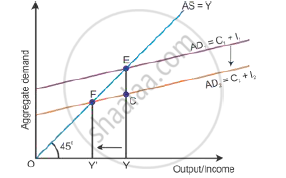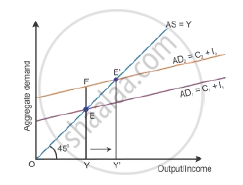Advertisements
Advertisements
प्रश्न
Explain national income equilibrium through aggregate demand and aggregate supply. Use diagram. Also explain the changes that take place in an economy when the economy is not in equilibrium
उत्तर
Aggregate demand and aggregate supply approach (AD and AS approach) Equilibrium level of income are attained only when aggregate demand is equal to aggregate supply. It is the level of output where producers plan to produce the amount of good is equal to consumers plan to purchase the amount of good. Thus, equilibrium is struck where planned output (AS) is equal to planned expenditure (AD) during a period of time.

Deficient demand occurs in a situation when the aggregate demand is short of the aggregate supply corresponding to full employment in the economy. It leads to a fall in the general price level and results in deflation, i.e. AD < AS. Aggregate demand is shown by the AD curve and aggregate supply is shown by the AS curve (as shown in the diagram below). While the aggregate demand curve and the aggregate supply curve intersect each other, the full employment equilibrium is attained at Point E. OY is the full employment level of output, and EY is the aggregate demand at full employment level of output. If the aggregate demand decreases below the full employment level of output from EY to CY, then the economy will have deficient demand, (EY − CY = EC).

Excess demand occurs in a situation when aggregate demand is more than aggregate supply corresponding to full employment. It leads to the reduction in inventories and inflation in the economy. This situation is considered an inflationary gap—the difference between aggregate demand beyond full employment and aggregate demand at full employment. Aggregate demand is the AD curve and aggregate supply is the AS curve (as shown in the diagram below). While the aggregate demand curve and the aggregate supply curve intersect each other, the full employment equilibrium is attained at Point E. OY is the full employment level of output, and EY is the aggregate demand at full employment level of output. If the aggregate demand increases beyond the full employment level of output from EY to FY, then the economy will have excess demand (FY − EY = FE).

APPEARS IN
संबंधित प्रश्न
State the determinants of aggregate demand.
What is 'consumption function'?
Explain the following concepts or give definitions.
Depreciation
What is ‘effective demand’? How will you derive the autonomous expenditure multiplier when price of final goods and the rate of interest are given?
Match the following Group:
| Group A | Group B | ||
| 1) | Aggregate Supply | a) | Expected receipts |
| 2) | Autonomous Investment | b) | Lord J. M. Keynes |
| 3) | Consumption | c) | Government Investment |
| 4) | A.P.C. | d) | ΔC/ΔY |
| 5) | Investment | e) | C/Y |
| f) | Addition to stock of capital | ||
| g) | Destruction of utility | ||
State with reason whether you agree or disagree with the following statement.
Aggregate demand depends only on the consumption expenditure.
Answer in detail.
Explain the determinants of aggregate demand.
Answer in detail.
Explain the equilibrium between Aggregate Demand and Aggregate Supply.
Answer the following question.
State and discuss the components of Aggregate Demand in a two-sector economy.
Answer the following question.
Describe the adjustments that may take place in an economy when ex-ante Aggregate Demand is greater than ex-ante Aggregate Supply.
On which factor Keynesian Theory of Employment depends?
An increase in aggregate demand of equilibrium level of income and employment causes an increase in ______
Aggregate supply is equal to ______.
Identify the correctly matched pair from Column A to Column B:
| Column A | Column B |
| (1) Y = AD | (a) Level of output at full employment |
| (2) Forward Multiplier | (b) Withdrawal of investment decreases income |
| (3) Paradox of Thrift | (c) People save less or same as before |
| (4) Multiplier (k) < 1 | (d) 0 < MPC < 1 |
A decrease in Cash Reserve Ratio will lead to ______
“In an economy Planned spending is more than Planned output”.
Explain its impact on the level of output, income and employment.
